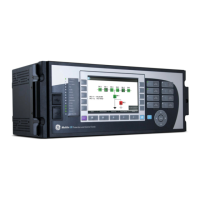CHAPTER 10: THEORY OF OPERATION OPERATING CONDITION CHARACTERISTICS
L90 LINE CURRENT DIFFERENTIAL SYSTEM – INSTRUCTION MANUAL 10-17
10
• A channel ID failure has been detected on at least one channel in a two-terminal single-channel system or in a three-
terminal system, or a channel ID failure has been detected on both channels in a two-terminal dual-channel system
All L90 communications alarms can be divided by major and minor alarms.
The major alarms are CHANNEL FAIL, PFLL FAIL, and CHANNEL ID FAIL. The relay is blocked automatically if any of these
conditions occur. Therefore, there is no need to assign these operands to a current differential block setting.
The minor alarms are CRC FAIL and LOST PACKET, which are indicators of a poor or noisy communications channel. If the
relay recognizes that a packet is lost or corrupted, the 87L feature is not processed at that protection pass. Instead, it waits
for the next valid packet.
10.2 Operating condition characteristics
10.2.1 Description
Characteristics of differential elements can be shown in the complex plane. The operating characteristics of the L90 are
fundamentally dependant on the relative ratios of the local and remote current phasor magnitudes and the angles of I
Ioc
/
I
rem
as shown in the Restraint Characteristics figure.
The main factors affecting the trip-restraint decisions are
• Difference in angles (+ real represents pure internal fault when currents are essentially in phase, – real represents
external fault when currents are 180° apart)
• The magnitude of remote current
• The magnitude of the local current
• Dynamically estimated errors in calculations
• Settings
The following figure also shows the capability of the relay to handle weak infeed conditions by increasing the restraint
ellipse when the remote current is relatively small (1.5 pu). Therefore, uncertainty is greater when compared with higher
remote currents (3 pu). The characteristic shown also depend on settings. The second graph shows how the relay's trip-
restraint calculation is made with respect to the variation in angle difference between local and remote currents. The
characteristic for three-terminal mode is similar where both remote currents are combined together.

